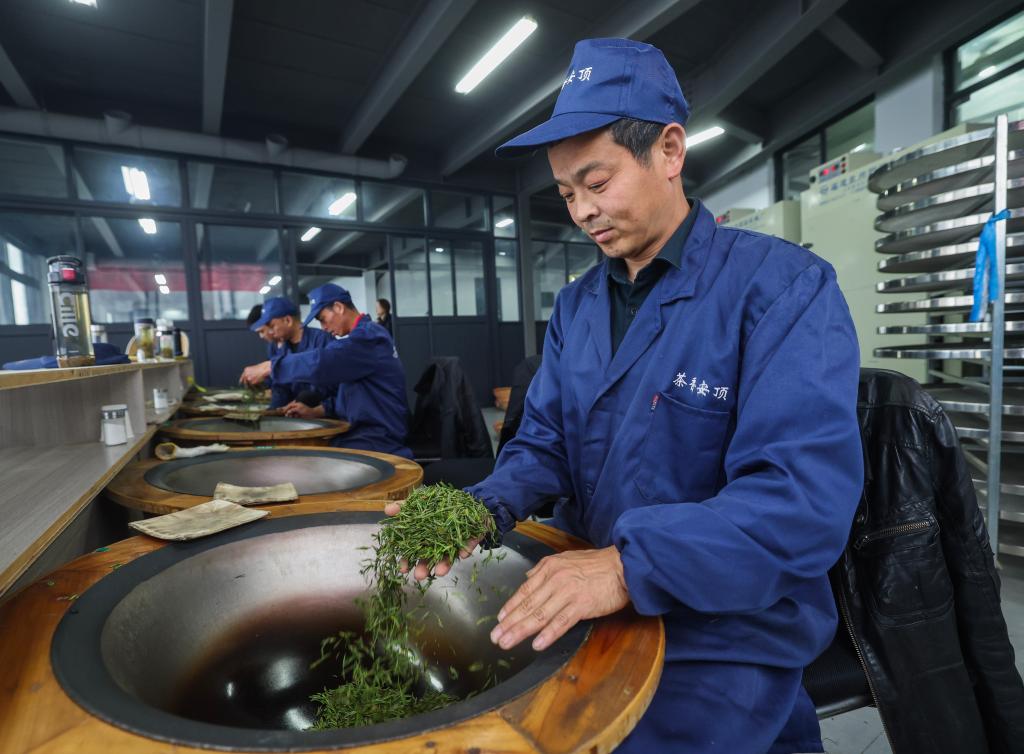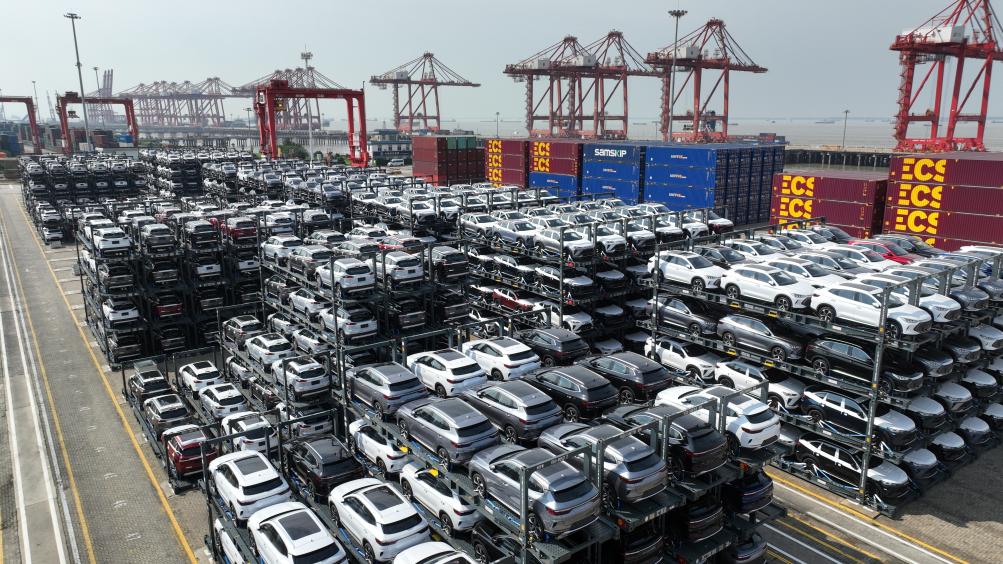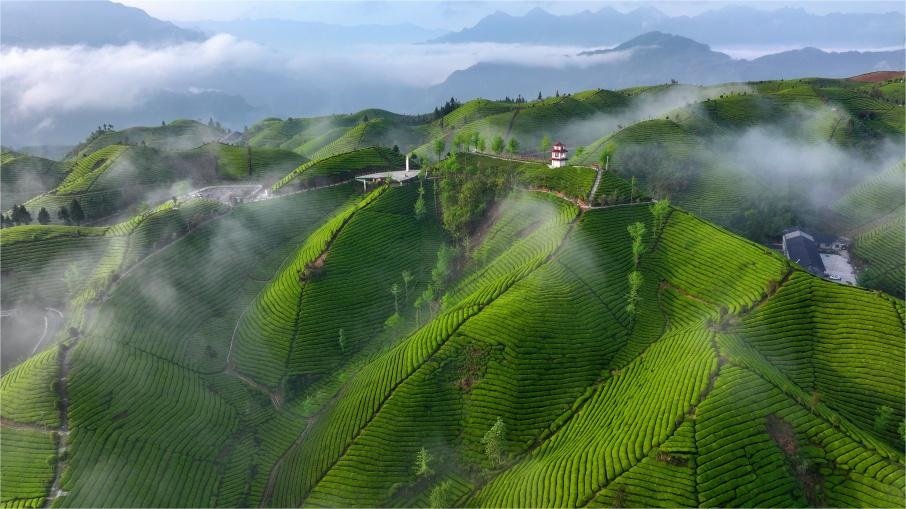Common prosperity goals catalyze regional cooperation in China's Yangtze River Delta
HANGZHOU, April 21 (Xinhua) -- The Yangtze River Delta, one of China's most economically vibrant regions, has set its sights on taking the lead in promoting common prosperity, with regional cooperation and local initiatives within its four provincial-level regions.
The delta, encompassing the provinces of Jiangsu, Zhejiang, and Anhui, as well as the Shanghai Municipality, generates nearly a quarter of China's gross domestic product (GDP), despite having just 4 percent of the country's total land area. Notably, urban-rural income gaps in the four regions of this delta are all smaller than China's average level.

This photo taken on March 20, 2024 shows tulips at the Bund area in east China's Shanghai. (Xinhua/Zhang Jiansong)
In 2021, China rolled out a guideline to build Zhejiang into a demonstration zone in pursuit of common prosperity. Two years later, China called on the delta to take the lead in promoting common prosperity and to strive for major breakthroughs in the integrated development of the delta.
Common prosperity, an essential requirement of socialism and a key feature of Chinese modernization, aims to create a future in which prosperity is shared by everyone in the country.
"The essence of common prosperity is affluence and sharing, or in other words, making the pie bigger and dividing it properly," said He Wenjiong, vice president of the Institute for Common Prosperity and Development of Zhejiang University.
BIGGER PIE
The delta has strengthened industrial chain collaboration as it continues to promote high-quality integrated development, showing determination to make a bigger pie for common prosperity.
As a major new energy vehicle (NEV) production base, it produces two out of every five NEVs in China. Through industrial chain cooperation, an NEV in the delta can contain chips and software from Shanghai, a power battery from Jiangsu, and a car body from Zhejiang, before being assembled in Anhui.

Robots weld bodyshells of cars at a workshop of Chinese electric vehicle (EV) maker Li Auto Inc. in Changzhou, east China's Jiangsu Province, Jan. 10, 2024. (Xinhua/Ji Chunpeng)
Zhang Yiqiong, who hails from a small village in Xianju County of Zhejiang, is one of the beneficiaries of these efforts in the delta. With a childhood dream of leaving her mountainous hometown for the big city, Zhang, 33, never expected to return to work for an NEV power battery plant in her hometown.
In 2023, half of the eight production lines of the power battery project became operational. When fully operational, its annual output value will exceed 20 billion yuan (2.8 billion U.S. dollars) -- doubling the county's industrial output.
"Now I earn nearly 100,000 yuan a year, almost the same level as my earlier job," Zhang said. "The plant will create over 6,000 jobs and many young people have returned for these well-paid jobs."
The NEV plant is just one example of how an industry cluster within a four-hour drive is being built across the region.
The industrial cluster has helped Hefei, capital of Anhui Province, to become one of the fastest-developing cities in the region. It is now home to six NEV manufacturers, including BYD and Volkswagen, with the NEV industry contributing to over 60 percent of its industrial output.

This photo taken on Feb. 1, 2024 shows a NEV production line at the NIO Second Advanced Manufacturing Base in Hefei, east China's Anhui Province. (Xinhua/Zhang Duan)
The rapid growth of high-tech industrial clusters has driven robust economic growth in the Yangtze River Delta. From 2018 to 2023, the region's GDP had risen to 30.51 trillion yuan from 22.1 trillion yuan.
The output value of its high-tech manufacturing contributes about 31 percent of China's total, with the integrated circuit sector accounting for 60 percent and biomedicine and artificial intelligence each contributing one-third.
NARROWING GAP
One of the priorities in promoting common prosperity is to narrow the income gap so that "everyone has a job and every family has a source of income," said Du Xuliang, head of the Zhejiang Provincial Development and Reform Commission.
Lu Guofei, who had suffered from a leg disability for more than 20 years, was offered a job at a smart sheep farm in Changxing County of Zhejiang Province three years ago. Lu, who is in his 50s, currently earns more than 5,000 yuan a month.
The sheep farm is part of the government's "common prosperity workshop" program. As the name implies, such workshops are a response to the government's call to narrow the income gap and achieve "common prosperity for all." These workshops are mostly opened in towns and villages to provide job opportunities for the unemployed, low-income earners, and farmers who wish to earn extra income during the off-season.
More than 10,000 "common prosperity workshops" have been established in Zhejiang, employing nearly 500,000 people who earn an extra income of some 2,600 yuan on average monthly.

Workers process tea leaves at a workshop of Anding Village in Lishan Township in Hangzhou, east China's Zhejiang Province, April 8, 2024. (Xinhua/Xu Yu)
The program has been replicated in other parts of the delta. In Shanghai, some workshops help sell agricultural products from Zhejiang. In Yangzhou of Jiangsu Province, woodcarving workshops help villagers earn over 3,000 yuan a month. In Lujiang of Anhui Province, 17 workshops have been opened, employing nearly 1,000 women.
Common prosperity requires narrowing the gap between regions and between urban and rural areas, Du said.
Zhejiang has seen a narrower income gap between urban and rural residents over the past two decades, with the income ratio falling from 2.43:1 to 1.86:1 -- the lowest in the country.
The regional gap is also a major obstacle to common prosperity, which should serve as the ultimate evaluation criterion for the high-quality integrated development of the Yangtze River Delta, said Chen Jie, a professor at Shanghai Jiao Tong University.

This aerial panoramic drone photo taken on July 11, 2023 shows new energy vehicles for export at a terminal of Taicang Port, east China's Jiangsu Province. (Photo by Ji Haixin/Xinhua)
Eight cities in Shanghai, Jiangsu, and Zhejiang have implemented a pairing assistance program since 2022 to support eight less-developed cities in northern Anhui through industrial transfer. In 2022 alone, the eight cities in Anhui received a total investment of 211.75 billion yuan from Shanghai, Jiangsu, and Zhejiang.
A livestreaming e-commerce company from Ningbo, Zhejiang Province, is helping to operate the first cross-border e-commerce industrial park in northern Anhui. Many companies there have built long-term partnerships with dealers from countries such as the United States, Canada, the Philippines, and the Republic of Korea, and now send nearly 30,000 parcels daily to customers, said Zhu Cheng, an executive with the livestreaming e-commerce company.
Photos
Related Stories
- Balance of loans up 12.7 pct in China's Yangtze River Delta
- Regional development index indicates robust growth of Yangtze River Delta
- Integrated development of Yangtze River Delta region promotes better livelihood
- Yangtze River Delta region to strengthen commerce cooperation
- Yangtze River Delta remains magnet for foreign investment
Copyright © 2024 People's Daily Online. All Rights Reserved.









